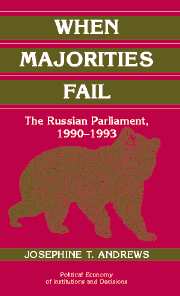Book contents
- Frontmatter
- Contents
- Acknowledgments
- 1 Introduction
- 2 Cycling in Action: Russia's Constitutional Crisis
- 3 Cycling and Its Consequences: A Theoretical Framework
- 4 Institutional Design and Implications for Majority Rule
- 5 Issue Dimensions and Partisan Alliances
- 6 The Structure of Preferences
- 7 Legislative Instability
- 8 The Dynamics of Agenda Control in the Russian Parliament
- 9 Implications of Disequilibrium in Transitional Legislatures
- References
- Index
3 - Cycling and Its Consequences: A Theoretical Framework
Published online by Cambridge University Press: 02 September 2009
- Frontmatter
- Contents
- Acknowledgments
- 1 Introduction
- 2 Cycling in Action: Russia's Constitutional Crisis
- 3 Cycling and Its Consequences: A Theoretical Framework
- 4 Institutional Design and Implications for Majority Rule
- 5 Issue Dimensions and Partisan Alliances
- 6 The Structure of Preferences
- 7 Legislative Instability
- 8 The Dynamics of Agenda Control in the Russian Parliament
- 9 Implications of Disequilibrium in Transitional Legislatures
- References
- Index
Summary
To understand how majority cycles undermine legislative decision making, it is necessary to understand the theoretical concept of cycling. Therefore, I begin this chapter with an exposition of a precise definition of cycling and its consequences. Following this, I discuss the most important solutions to cycling that have been developed by formal scholars of legislatures. The earliest studies, beginning with Kenneth Shepsle's path-breaking article (Shepsle 1979), focus on how institutional design in the form of committees and rules can prevent cycling. More recent studies – in particular, Gary Cox and Mathew McCubbins' influential book – analyze how political parties, in conjunction with committees and rules, prevent cycling (Cox and McCubbins 1993). Following Cox and McCubbins, John Aldrich shows formally how, in a two-party setting, institutional design and the organization of preferences work together to prevent cycling (Aldrich 1995a). In a multiparty setting, work by Schofield (Schofield 1993) shows how the ideological location of parties, even highly organized parties, cannot prevent cycling if the issue space is multidimensional and parties can be differentiated along more than one of the dimensions. Therefore, in multiparty settings, committees and rules are critical to preventing a breakdown in majority rule.
CYCLING: DEFINITION AND DISCUSSION
Kenneth Arrow first showed that it is generally impossible to amalgamate individual preferences in a “fair” manner such that a consistent and stable social preference is established (Arrow 1963).
- Type
- Chapter
- Information
- When Majorities FailThe Russian Parliament, 1990–1993, pp. 70 - 86Publisher: Cambridge University PressPrint publication year: 2002



